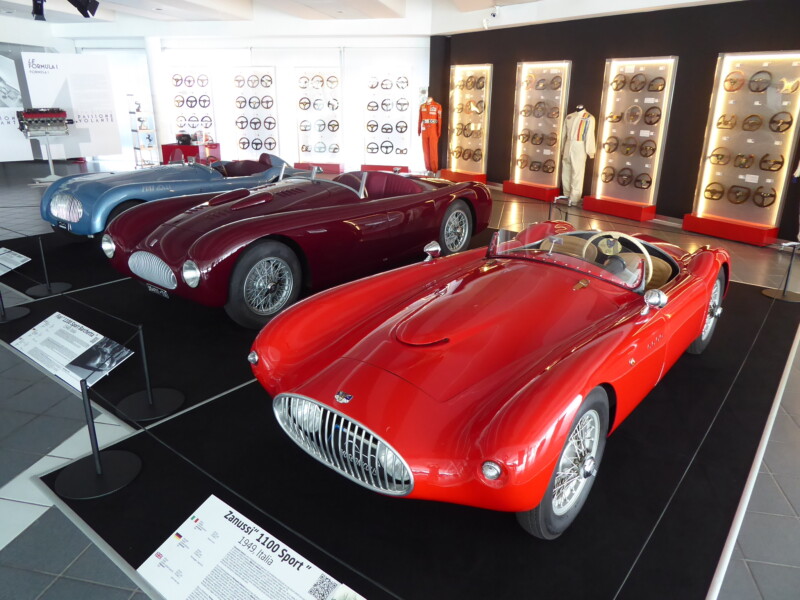Some years ago, at an event, the precise one I forget now, I picked up a leaflet for the Museo Niciolis, and duly added this to the list of places that i wanted to visit. It is located in Villafranca, a small town just off the autostrada which goes up from Modena past Mantova and on towards Verona, and so it was more a case of waiting until I was in the area than any other reason why it has taken a few years to be able to get there. When I looked at a map, I realised that in fact, it really is not that far from Modena, itself only a short trip from Bologna where I was staying for a few days break in June 2022, and thus there was no reason not to include it in my schedule. It’s not the sort of place you would find by accident, as the museum is situated at the end of a series of roads in an industrial unit in Villafranca, a little known town town just south of Verona, though when you get fairly close, it is signed, so you might just find it without the aid of a sat nav system.
The Museum opened in 2000 in a 6000 square metre modern building with five floors. It owes its foundation to the enormous passion of Luciano Nicolis for collecting unique technical and mechanical items. The museum houses 10 collections, every single of one of which is sizeable in its own right: around 200 cars, 110 bicycles of the great champions, 100 motorbikes, 500 cameras and movie cameras, 100 musical instruments and jukeboxes, 100 typewriters, 100 Formula 1 steering wheels and road car steering wheels as well as a number of small airplanes and instruments, a military area with relics of the First and Second World War, models of cars, motorbikes and trains, and original works of human talent. On one side of the exhibition building the museum provides a Meeting Centre, the “Room of Ideas”, tourist activities, a Documentation Centre, a Library and a one of the best stocked Bookstore concerning the motoring world. If you want to study it all, you should allow 2 – 3 hours, as there really is a lot to see.
CARS
There are two separate display areas on the ground floor, to either side of the reception. To the left are a series of cars from the early days of motoring, along with some motor bikes, and other memorabilia and to the right are a more varied mix of cars from some very elegant 30s machinery through some Fiat based post war sports cars to more recent exotica.
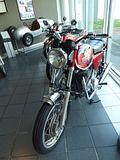
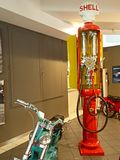
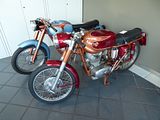
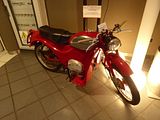
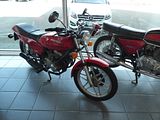
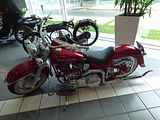
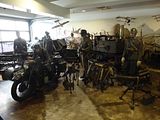
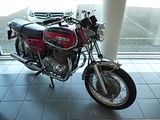
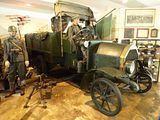
1898 Darracq Phateton: Alexander Darracq was born in Bordeaux in 1855 and he was one of the fathers of the French automobile industry, one of the first entrepreneurs who believed in its potentials. After selling the “Gladiator” bicycle brand, Darracq founded the Usines Perfecta to build bicycle and car parts; to start the car production he bought an already-made project developed by Lèon Bollée, another French designer from the early days of motoring. In the early 1900s, several European manufacturers used Darracq patents to build their cars and Darracq started several enterprises outside France (in Italy he founded the Darracq Italiana from which Alfa Romeo will later born). The frame shown in the Museum is the first 4- wheeler Darracq project powered by a Bollée engine and probably originally fitted with a phaeton body from which it takes the model name. It is interesting to notice the chassis with central beam, unusual at the time, and the steering wheel central position (with the driver sitting on the left). They made three examples, but this is the only one remaining.
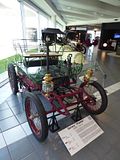
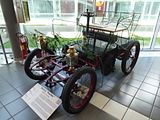
1892 Adventure: This is a one-off pedal vehicle created for road use. Designed by two French inventors, it was driven by them in 1882 from Paris to Calais. On the way back to Paris, the vehicle was forced to stop for a mechanical/structural failure in Rouen, where it was left in a cellar. Later the two friends hid it and left for the war (where it is believed they died). Only their two helmets are left, that can be seen in the showcase at the Museo. In the 1960s the Aventure drew the attention of Monsieur Jacky Pinchon, the owner of the Clères French museum. He immediately understood the historic importance of the vehicle and brought it to his museum near Paris, where it will be exposed until 1970, when the vehicle started being restored. In 1991 the vehicle was auctioned by Sotheby’s in London as a prestigious collectible. A peculiar feature is the steering wheel, that was fitted on the vehicle many years before the application of petrol engine on a car. The difference in the crew’s jobs is bizzarre: the driver in the front seat turned the wheel and the one in the rear seat pedaled. Two original candle carriage lamps are installed on the both sides.
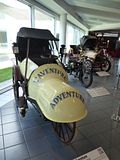
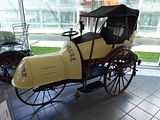
1898 de Dion Tricycle: De Dion Bouton & Co. was founded in Paris in 1883 and initially produced steam boilers that were fitted to the first cars; from 1893 the company started to build internal combustion engines for the automobile industry. The first De Dion Bouton Tricycle was presented in 1895 and is considered the first real popular individual means of transport: it was produced until 1903 and was sold not only in France, but also England and Italy. Originally producing 0.5 bhp, the four-stroke single-cylinder engine with two-speed gearbox, kept on being developed until it reached 3.5 bhp in 1903; it could overcome a 10% gradient slope without the need to pedal. Particularly interesting was the dry battery which provided electricity for ignition; it had an autonomy of 150 hours. An appreciated optional of the period was a small trailer, built by Belvalette coachbuilder, which, attached behind the tricycle, allowed to carry two passengers. The company, holder of many motoring patents, such as the famous De Dion rear axle, stopped production in 1933.
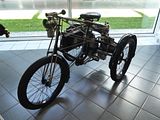
1906 Ansaldo PF-1VA: The origins of Ansaldo date back to 1853 when Giovanni Ansaldo, a 24-year-old university teacher, came back to Italy after living in North Europe for a while and founded the Company Gio. Ansaldo & C. to build steam trains and ships. The company had the idea of a car production even before the end of World War I, assuming that aeroplane production would stop once the war was over and it would have then been necessary to switch from war production (heavy artillery) to civil manufacturing. The prototype of the first Ansaldo type 4A was built in 1919 and the company started selling its first cars in 1920. The model on display is a world premier (and a production ante litteram), built in the Ansaldo workshops even before they actually had a department for car production. This one-of-a-kind model, built on a Peugeot frame, is powered by a Peugeot single-cylinder engine, chain drive, De Dion rear axle and wooden-spoke wheels.
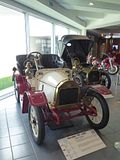
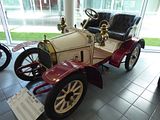
1904 Peugeot Type 58: The first officially documented owner of a car in Italy was Gaetano Rossi, the owner of the Lanerossi industries in Vicenza. In 1892, he put an order in to Peugeot for a car with a Daimler engine, complete with a soft top and folding seats, for which he took delivery on 2nd January 1893. It was the 25th Peugeot ever made and the first to drive around Italy. In 1896, encouraged by the sporting success, which boosted sales, Peugeot began to build cars using engines of their own design and construction. In 1899, the first Peugeot car dealer in Italy was opened and in 1900 the total production of the French car manufacturer had already reached 500 cars per year. The vehicle in the Museo is a Tipo 58, an upgrade of the Tipo 56 which, presented in 1903, did not meet with great commercial success. It is powered by a single cylinder square engine (bore and stroke: 102x102mm) with two main bearings. The clutch is cone-shaped and the shaft-driven transmission has 3 gears. The “mother-in-law’s” retractable chair is rather strange and can be put on the back of the car when needed.
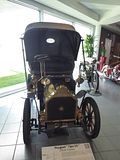
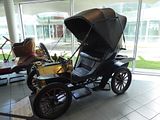
1931 Bugatti Type 49: Ettore Bugatti was born in Milan in 1881 and since his childhood, he had a strong inclination for mechanics, he especially demonstrated to be able to join functionality and aesthetics. After modifying a “Prinetti & Stucchi” tricycle by fitting it with two engines, he designed his first car when he was only 18 in 1899: from that moment on he started to become part of the international automobile history. The “Type 49” was introduced at the 1930 Paris Motor Show; it is considered the last Bugatti designed by Ettore, who later left the company to his son Jean. Replacing the Type 44, the car has a single overhead camshaft engine, three valves per cylinder and twin spark ignition. The beautiful aluminium wheels have incorporated drum brakes . The Type 49 is the classic Bugatti touring car and it was fitted with several types of bodies (sedan, convertible, coupé) either built by Bugatti or by famous bodybuilders of those days. The car shown in the museum was driven by the famous French driver Louis Chiron during the 1964 International Rally in Chioggia. It was also used in the 1965 movie Grand Prix

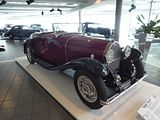
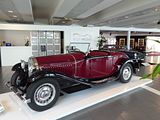
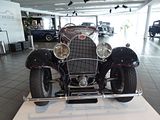
1929 Isotta Fraschini “Tipo 8A”, Castagna. The “Società Milanese d’Automobili Isotta Fraschini” was founded in Milan in 1900 by a group of enthusiasts and soon became one of the most prestigious Italian luxury car manufacturers. The Tipo 8, presented in 1919, was one of the first production cars in the world fitted with an inline-8 engine. The Tipo 8A, evolution of the Tipo 8, is a particularly luxurious model and about a third of the cars produced were shipped to the US, heading to a small amount of wealthy lucky owners. The dimensions were monumental; the interior were sophisticated lounges, lavishly decorated with crystal, silver and briar and upholstered with elegant Damasque cloths. The body type is a Laundalet Imperial “Trasformabile” (“convertible”), typical on most prestigious cars, with the rear opening roof and the two-tone paint.The 8A is the car used by Norma Desmond in “Sunset Boulevard”. Many people owned this iconic car like Billy Bis, the 70s comic hero of the magazine Intrepido. But also Rodolfo Valentino, Gabriele D’Annunzio, Benito Mussolini, and other internationally known names.
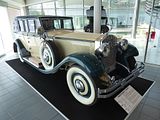
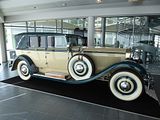
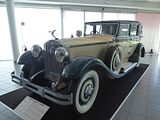
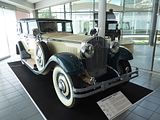
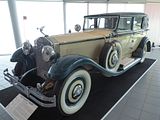
1928 Lancia Lambda Series 8: The Lambda is Vincenzo Lancia’s masterpiece: the first mass-produced car with a monocoque chassis. A futuristic car which quickened the research and thanks to its technical innovations, became the precursor of modern cars. Produced for 9 years, from February 1923 to September 1931, in 9 series for a total of about 13,000 examples, it marked, as a few other cars, the history of automobile: if the Ford T and the Volkswagen Beetle motorized the world, while the Austin Mini was the precursor of modern popular cars, the Lambda showed what the future looked like and paved the way for all the other car manufacturers in the world. It seems that the revolutionary idea came from Vincenzo Lancia himself, who got inspired by the building process of boats. The concept of a separate chassis, with the body fitted onto it, was antiquated (even if it will definitely disappear only in the 1950s). Another feature of the car, as much revolutionary, was the telescopic front suspension with independent wheels and hydraulic shock absorbers, a design of the ingenious designer Falchetto. The car shown in the museum was rediscovered in Liberia. On the left side you can see an unusual luminous front arrow, while on the right side an original adjustable headlight with a mirror on the rear. The radiator cap has a water temperature gauge and the dump registration plate hides the old-fashioned handcrank.
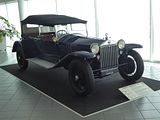
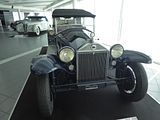
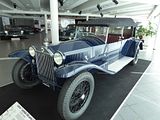
1939 Delahaye 135M Figoni: In 1879 the engineer Emile Delahaye took over a firm established in 1845 that produced machinery for the bricks industry. He named the company after him and converted it to the production of internal-combustion engines and in 1894 he started making cars. Delahaye remained active until 1954 and greatly represented, together with Bugatti, Hispano-Suiza, and Delage, the French “grandeur” in motoring history The 135 model, both in touring and racing versions, was perhaps the one that granted the highest international reputation to the French brand. The 135 model was dressed by the most “flamboyant” creations of the great French coachbuilders; On the car shown in the Museum, you can notice the building quality and care which Henry Chapron put in the soft hood: it is possible to place it in the “milord” position, partially closed to protect just the rear passengers. This car is equipped with a Cotal electromagnetic gearbox, the ancestor of the modern automatic gearbox. It had 4-speed and 4 reverse gears! In 2008 the car was the protagonist of the movie “Wild Blood” where Luca Zingaretti and Monica Bellucci drove the refined 1939 Delahaye 135. The movie was launched at the Cannes Festival of Cinema di Cannes in the same year by the film director Marco Tullio Giordana. “Giordana reflects on the Italian population during the Fascist regime by talking about two characters who really existed. The human and artistic parable of Luisa Ferida and Osvaldo Valenti, two famous actors of the Fascist cinema that joined the Republic of Salò. The movie was nominated twice and won an award during the Nastro d’Argento and 2 David di Donatello nomination.”
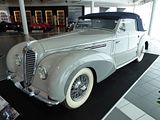
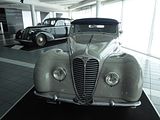
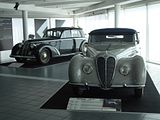
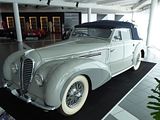
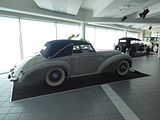
1963 Ferrari 250 GT/E: The car shown in the museum is the first production 2+2 Ferrari model; thanks to Pininfarina’s ability, it was possible to fit a 4-seater body on the 250 GT chassis without modifying the wheelbase. The overall car length turned out to be 30,5 cm longer. Developed in the wind tunnel, the car has a very sloping windshield that perfectly matches with the roof. The clean and linear style of the side, with no unnecessary ornaments, will be used by Pininfarina on other creations of the period. Starting with the Europa model in 1953 and ending with the last GT Lusso produced in 1964 , the 250 series was one of the most long-running in Ferrari’s history and also one of the most famous and successful. Enzo Ferrari himself loved driving the 250 GT 2+2, thanks to the sporty-comfortable feeling of these cars. For over ten years, the 12-cylinder 3-litre engine (the series was named after the 250cc cubic capacity per cylinder) was used to race all over the world in all its various evolutions and was fitted to cars whose names will always remain in the heart of enthusiasts: 250 SWB, 250 Testarossa, 250 Spyder California, 250 GT Lusso and the famous 250 GTO.
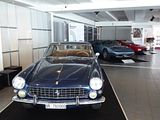
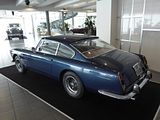
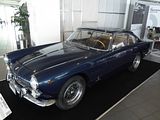
1973 Maserati Indy 4900: Driven by Wilbur Shaw, the Maserati 8 CTF won the 1939 Indianapolis 500 Miles race and Maserati was the first European (and Italian) car industry to win it after Peugeot in 1914. The little Bolognese firm succeeded in what Fiat, Mercedes, Alfa Romeo, and Bugatti failed. The same car, again driven by Wilbur Shaw, won the 1940 Indy edition too and entered the automobile legend as for the first time in the most important American race history a car won two editions. To remember these triumphs, Maserati called “Indy” the car introduced at the 1968 Turin Motor Show. The Indy was the obvious evolution of the Mexico, that is a fast coupé also comfortable for four people. During the production years, the most important modifications concerned the engine; in 1970 it was enlarged to 4.700cc and the car got the name Indy America; since 1973 only the version fitted with the 4.900cc engine (the same unit already fitted to the Ghibli SS) remained in production. The Indy was a good sale success and was produced also after Citroen took over the company from Modena.
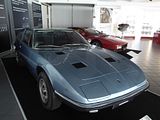
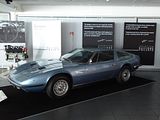
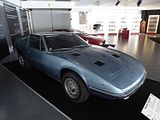
1936 Lancia Astura Berlina Gran Sport: The Lancia Astura, a name inspired by a famous medieval castle in the Lazio region, was built at the same time as the Lancia Artena in 1931. These two models are the heirs of the Lambda and the Dilambda and were the production companies attempt at fitting out a more sombre and less expensive vehicle (the Artena) as well as a powerful and sporty car (the Astura). This decision was also influenced by the austerity of the times (following the Wall Street Crash in 1929). The first and second series were available until 1933. With the introduction of the 3rd series, the vehicle underwent some substantial modifications, from an increase in power to the fitting out of two versions: L (long wheelbase) and C (short wheelbase). The tilted radiator became a basic feature as did the shield emblem which replaced the round one. This version is doubtlessly the one which bore the most prestigious bodywork. Not being a vehicle with a monocoque body, body workers were able to express their creativity and produce a more elevated style. This example is the 4-light passenger model, a luxurious saloon car favoured by those who loved to drive their own vehicle rather than be chauffeur-driven. Illustrious names like Pinin Farina contributed to making the Astura one of the top cars in the 1930s. The 4th and last series of the Lancia Astura, produced up until 1939, is remembered mainly for becoming the large torpedo-shape representation vehicle commissioned by Mussolini at a time when the Italian government needed ministerial vehicles. It was designed by Mario Revelli di Beaumont, one of the most creative designer of Pinin Farina.
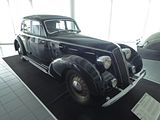
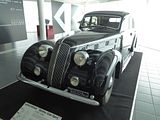
1949 Zanussi 1100 Sport: Fioravante Zanussi (born in Pasiano di Pordenone in 1894, died in Treviso in 1960) was an amateur racing driver. He also prepared and manufactured racing cars, this latter activity on a small scale. In his workshop in Treviso, opened in 1919, he prepared hundreds of cars for local gentlemen drivers. To date, however, there are only seven cars known to have been produced by Zanussi, the first being a Fiat 508 C 1100, built just before the Second World War. In December 1951, Zanussi purchased a 1929 Alfa Romeo 6C 1750 Compressore. This car’s documents were used for the Zanussi 1100 Sport, and the changes made to the car were recorded in them in October 1952. This work resulted in a completely new car, a one-off built around a rectangular steel chassis, designed by Zanussi, tapered at the front, and with a flat floor. The Zanussi 1100 Sport was originally equipped with the Alfa Romeo 6C engine (minus the fifth and sixth cylinders), which Zanussi himself had boldly modified in a 4-cylinders unit, lowering its displacement to 1168 cc. However, by the end of 1960, when the car was sold by Zanussi’s heirs, the engine had already been replaced with a 1086 cc Fiat Tipo 1100 B unit, probably due to reliability issues. This change was officially recorded in the summer of 1961, when the “Alfa Romeo Tipo Zanussi” was issued with a new vehicle registration document and assigned new license plates. The barchetta-type aluminium bodywork was the work of Treviso-based coachbuilders Carrozzeria Fratelli Vendrame, which dressed all of Zanussi’s cars. This car is a wonderful example of the so-called racing specials built in Italy in the 1950s, usually on a Fiat base, often with an economic support from Fiat. This solution allowed numerous local “tuners” to enter races in spite of having limited financial resources.
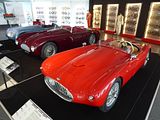
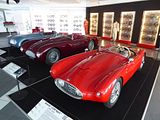
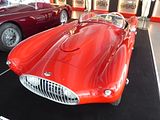
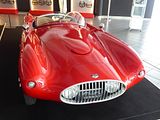
1948 Fiat “1100 Sport Barchetta” Mille Miglia, Motto: The body of this Fiat 1100 Sport Barchetta was fitted by Rocco Motto from Turin, the frame was modified by Stanguellini in Modena, the engine was tuned and oil cooling tubes were added. This one-off took part in the 1948 Mille Miglia with Pedretti Alessio with no. 395. When the war was over in 1945, many small shops built sports cars gathering various parts, but the several enrolments of Fiat 1100 S in the Mille Miglia race proved that that model was always the most appetising. This marvelous car still has its original log book. Its last owner, a doctor, used it to visit his patients. During that period the car therefore underwent some necessary modifications, like moving the spare wheel on the bonnet to make more room in the trunk for the doctor’s instrument. The founder of the Museum, Luciano Nicolis, found it around Europe and, after a meticulous restoration, the car went back to its original splendour. At the 2021 Poltu Quatu Classic concours d’elegance this car won the prestigious “Spirit of 1000 Miglia” trophy, an official Mille Miglia award for the car that best represents the essence of the Red Arrow, the race Enzo Ferrari described as “a travelling museum unique in the world”. The cars are selected considering all the eligibility characteristics for the 1000 Miglia race. It was also awarded with the “Best in Show” prize.
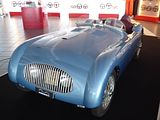
1949 Fiat 500 Sport Spider Colli: Probably a one-off, the car shown in the museum was built by the Carrozzeria Colli of Milan on a chassis powered by a Fiat-derived engine. The years following the end of World War II witnessed the growth of both drivers and technicians. Among the small coachbuilders of the period, an important place was occupied by Carrozzeria Colli of Milan, founded in 1932 and specialized in aluminium handcraft work. During the war Carrozzeria Colli cooperated with the Air Force and soon after the war the experience gained from this collaboration led the company to manufacture a special vehicle, half-car and half-plane, with wings that bent upwards when driving on the road. In 1948 the Aer 1, a three-seat prototype, was able to make some trial flies. Although interesting and appreciated, the the vehicle was never produced. Carrozzeria Colli kept manufacturing special car bodies until 1973 and in the 1950s cooperated with Alfa Romeo, for which they dressed both racing (as the 6C 3000CM and Disco Volante) and road cars (as the station wagon versions of the Giulietta and Giulia).
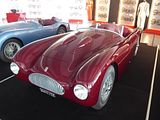
1991 Ferrari Testarossa: At the 1984 Paris Auto Show Ferrari launched the 512 BB heir, paying homage to an important name for the prancing horse company after 27 years: Testarossa. Powered by the 180° V12 of the predecessor, the Testarossa is able to reach 290 kilometers per hour and cover the 0-60 in just 5.8 seconds. In addition to the remarkable performance, the new Ferrari amazes for its design, signed by Pininfarina: the wide rear end that makes room for the engine and the big lateral grilles that contribute to the cooling, characterized the car in a unique way. The Testarossa is liked and its appearance in the famous TV series “Miami Vice” helped it becoming one of the car symbol of the 80s together with its rival, the Lamborghini Countach. Visually and mechanically updated in 1992, the car changed name in 512 TR and later in 1994 the last evolution of the project came out, called F512 M, the last Ferrari powered by with a flat V12.
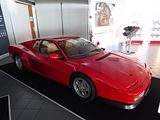


1941 Fiat 1500C Bertone: The 1500 was unveiled at the 1935 Milan Car Show. The engine was based on the “Balilla” one with two cylinders added, reaching a total displacement of nearly 1500cc: almost a size record for an inline 6. Carrozzeria Bertone was the first to make its own interpretation of the new Fiat model: in 1936 they had already launched some sedans that enhanced the streamlined stock model with their lines. The body of the car was drawn by Mario Revelli of Beaumont during the last years of WWII and built by Bertone in 1945 on a 1941 chassis. The research of new styles and aerodynamic concepts is evident: the windshield angle, the front fenders that join the rear ones, anticipating the future “ponton” bodies (where the wheel arches and lights merge with the body). The front grille is peculiar, with the center shield and two lateral moustaches that recall the typical Alfa Romeo front end. “Two long streamlined lines comes from the front end, shaping the front and rear fenders, joined by a single line that goes down and gets thinner near the doors. After the rear wheels, these waves softly disappear into two smooth fins without rear lights.” Fonte: La Manovella, Aprile 2008.
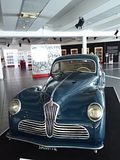


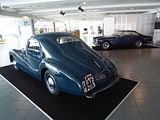
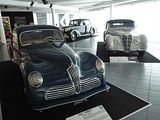
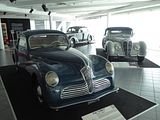
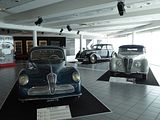
The majority of the cars are on the first floor, and I was surprised by how many and how varied they were. There is a strong emphasis on Italian cars, as you might expect with plenty of Lancia and Maserati cars, grouped together.
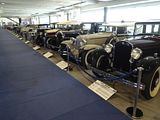
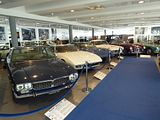
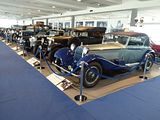
1923 Alfa Romeo RL: The RL was designed in 1920 following the technical requirements of the new “3000” racing formula that entered into force in 1921. Produced in seven series and four models (both racecars and road cars) until 1927, the car collected many racing successes, like the 1923 Targa Florio, won by Ugo Sivocci behind the wheel of an RL Targa Florio. The car exhibited at the museum still has the Alfa Romeo badge without the laurel wreath, which was added later, after the company won the 1925 World Championship. This car was sold as a rolling chassis (a common practice for prestigious cars at the time) in Australia, where it was fitted with a torpedo body built by the coachbuilder Martin King from Melbourne. The windscreen wiper is manual and controlled from the cockpit; the horn is electric, but the car is also fitted with a manual operating trumpet since the batteries often had insufficient range. The rear mirror is placed on the back of the headlamp, located on the chauffeur’s right side. Luciano Nicolis used to say: “This car comes from Australia, it’s very reliable and I attended many car meets like the Sardinia and Sicily tour with it. I consider this a significant car”
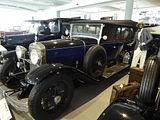
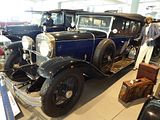
1925 Alfa Romeo RM Zagato: Using many mechanical and chassis parts from the RL model, Alfa Romeo launched an economic version of its flagship car in 1923. Designed more as a family use rather than a sports model, the RM had a 4 cylinder engine directly derived from the 6-cylinder fitted in the RL. The car exhibited at the museum is fitted with a body built by “Zagato” from Milan, the body shop founded by Ugo Zagato in 1919, and has been kept unaltered over the years. In 2003 it won the important Louis Vuitton Classic elegance award, in the Veteran and Vintage category, and won the Special Award from the Jury for its excellent state of preservation. This car is practical and elegant as a formal torpedo with the sporting style and lightness typical of a Zagato creation, features that made the name of the Milanese coachbuilder successful throughout the world.

1931 Alfa Romeo “6C 1750 GTC”, Castagna: The 6C 1750 was the car that drove Alfa Romeo to the Olympus of sports car companies. This lucky project, signed by Vittorio Jano, allowed Alfa Romeo to win the 1928, 1929 and 1930 editions of the Mille Miglia. The 6C 1750 Gran Turismo Compressore is the last evolution of this sports yet elegant car; this model was requested by a refined elite of enthusiasts that were able to understand the touring potential of the supercharged engine. The wheelbase is 6 cm longer than the previous series, the transmission and the front axle derived from the 8C 2300. Pinin Farina, Touring and Castagna, among the others, created for the GTC some of the most beautiful Italian car bodies of the period. It’s interesting to notice the finish of the folding top and the trunk design. It’s a masterpiece, a 4-wheeled sculpture. One of the elements that makes this car unique is the pearlescent paint made by mixing nacreous dust from crumbled seashells with the paint. Luciano Nicolis used to say: “This is an Alfa Romeo 1750 with supercharger, a car that amazed the entire world because it was faster than the Alfa Romeo 3000, the car that kept winning at the time. Then they set the limit to 2000cc and it could not be used anymore. So Alfa Romeo made the supercharged 1750, that turned out to be faster than the 3000. Our car came 1st in its category at the International Concours D’Elegance – Louis Vuitton Classic – in Parc du Bagatelle. The Alfa Romeo 1750 was considered a very elegant yet fast car. We’re talking about the 30s, 1931 to be precise: the design is still marvellous. This 1750 was repainted in the pearlescent original colour, made by mixing paint with fish scales and seashells’ dust. The headlamps were manually adjustable, so much so that they used to say – …raise …lower the headlamps – and you adjusted them with a lever. The engine is a masterpiece too, 6 cylinders with front supercharger”.

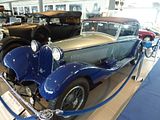
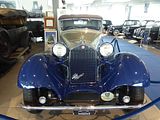
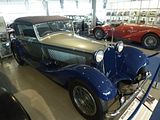
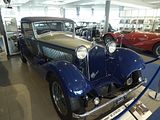
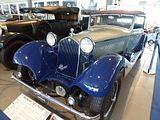
1957 Alfa Romeo Giulietta Berlina Ti: In April 1954 a new car entered the automotive world with her eye-catching style and an attractive name: Giulietta. The Sprint version (a coupe designed by Bertone) was unusually launched first, followed by the sedan model in 1955 that, together with the Fiat 600 and 1100 and the Lancia Appia, will help the Italian motorization. The sedan, with 4 doors, 4 seats and column shifter, was very nimble and fast too, reintroducing the philosophy of pre-war Alfa Romeos: good speed, handling, reliability, and elegance. Thanks to the design updates in 1959 and 1961, the public kept loving the Giulietta during the following years, consolidating the commercial success and creating its legend. The car exhibited at the Museum is a Giulietta t.i. (International Tourism), a more powerful version introduced in 1957 that soon became the best selling version.
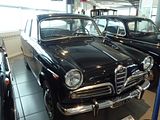
1924 Ansaldo 4/CS: Ansaldo Automobili, a branch of S.A. Gio. Ansaldo in Genova, was founded in 1918 and survived with different names until 1945. The 4 CS is the sports version of the 4 model, launched in 1919, and contribute significantly to build the success of Ansaldo as a sports car manufacturer. The car shown in the museum was purchased new by Ettore Mayr, Ansaldo dealer for the Trentino area: his car had to be, as a demonstration vehicle, faster than the series production cars. Mayr, after visiting the factory to choose his car, confessed his sports leanings and so had the cylinder head slightly tuned to add a few more horsepower to his 4/CS. The tuning, together with the stock short 3-speed gearbox, allowed him to cover the flying kilometre, measured by the Automobile Club of Trento, at 119 kph and win several races, such as the 1925 Trento-Bondone hill climb race.
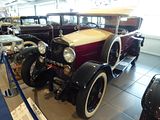
1930 Ansaldo Tipo 22: This is the most prestigious model built by Ansaldo. The “Tipo 22”, rare and refined car, has a modern chassis fitted with an engine able to guarantee brilliant performances even with the monumental bodies of the time. Unfortunately the production started during a period of international crisis, so it didn’t earn enough commercial success to solve the financial problems of the company. The car shown in the museum covered just 3.000 km from new, and still has the original leather interior. The original log book (that can be seen in the showcase near the car) proves just one change in ownership. The first owner was Nicola Frugone, a wealthy and well-known man of the Ligurian Riviera. In the passenger compartment, the vanity case has silver accessories and there is also a refined petrol lighter bearing the Ansaldo badge. The peculiar original rubber running boards to clean your shoes before getting inside. The gear lever is rather singular too: it has a lock with a special security key, one of the first car antitheft devices. Luciano Nicolis used to say: “This Ansaldo was bought by a well-known wealthy character from Liguria, who lived in Chiavari. He didn’t drive it much because he had to leave for the United States and left the car in his castle. It was basically new when I’ve found it! The plate is original too”.
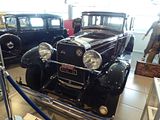
1937 Austin Heavy 12/4 Taxi Cab, Jones Brothers: Who’s never seen, at least in a movie, a London taxi? Black, high, imposing they are really one of the features of the City. Yet, in the Thirties the archetypal of the London taxicab was a different car, a landaulette or a saloon with the rear part of the roof that could be opened to allow the passengers to admire the City sights. One of the coachbuilders specialised in building the taxi landaulette bodies was Jones Brothers, a Bayswater, West London-based firm which utilized for their creations the indestructible Austin Heavy 12/4 chassis. The Heavy 12/4 had a not very powerful but highly reliable engine: built in the 1930s, during World War II the Jones Brothers landaulette taxicabs were used as fire-engines and remained in service along the London streets until the early Sixties, when they became the favourite hippies’ means of transport for their tours around the world. The car shown in the Museum has been restored in England in the mid-1990s: it still has its script on the roof, the taximeter and the leather straps necessary to fasten the passengers’ luggage in the proper place on the driver’s side.
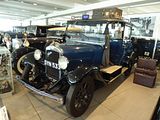
1919 Baker Rauch & Lang “Double Drive Coach”: Electric powertrain was successful both in Europe (the first person who reached 100 kph was the Belgian Camille Jenatzy in 1899 in his electric torpedo “Jamais contente”) and in the USA, where in 1894 the first electric taxi cabs were driving around New York; in 1904 one third of the entire American car pool on the road was electric and in 1912, they produced 10.000 electric vehicles per year. The electric car was silent, simple, clean and easy to handle: in fact it was the favourite car of high class ladies, who could use it without the help of the chauffeur, that driver-mechanic who was necessary for the complicated petrol cars of the early 1900s. From the Twenties, electric powertrain was only used for commercial vehicles: do you remember the milk delivery vans in American movies? The car displayed at the Museo was built by Baker, Rauch & Lang. It could be driven, through a metal bar, both from the front and rear seats: in this latter case, the two front seats could be moved facing the rear ones and the interior became a perfect lounge! Considering that the car didn’t make much noise, a mechanical system sounds a bell similar to a tram when reversing the car. The car has a driving autonomy of about 70 kilometers. In the 70s the Baker-Raulang e Moto Truc was bought by Linde AG, the biggest elevator and industrial material handling company, renaming it Baker Material Handling Corp. Luciano Nicolis used to drive it around Villafranca to prove that even in the 21st centruy this electric car was still reliable.
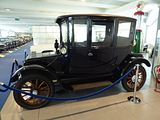
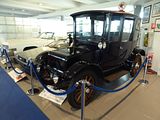
1886 Benz Patent Wagen: In 1885 Karl Benz (Germany 1844-1929), almost at the same time of the other German technician Gottlieb Daimler, built a tricycle with a petrol-driven engine which he tested himself, around Mannheim streets, where people were amazed by seeing it. The carriage “without horses” was about to be invented. The “Velociped” is considered the first petrol-fuelled car in the world and was designed in three different versions from 1886 to 1888. The third model became famous because of Benz’s wife, named Bertha, who drove it on August 1888, from Mannheim to Pforzheim, with her two sons. The car shown in the Museum is a perfect replica of Modell 1, named “Velociped”, patented on January 29th, 1886 with the n° 37 435. Benz didn’t only fit the engine to a carriage, replacing the horses, but he was the first who imagined a purpose-built chassis. The 1-speed “Velociped” working was very simple: the four-stroke horizontal monocylinder engine, without carter, lubricated by oilers and with ignition by Ruhmkorff coil and evaporation carburettor, transmitted the power to a secondary shaft with differential through a leather belt. The motion was transmitted to the wheels through the chains. This first model produced 0.75 bhp at 400 rpm, could reach the incredible top speed of 16 kph! The car was part of the prestigious “Collection de Mercedes du Musée de Schiffdorf”, following the premature passing of the collector Rolf Meyer it was then bought by Luciano Nicolis.
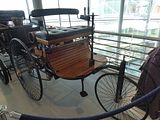
1914 Benz 8/20 PS Jagdwagen: The most important automotive companies in the early 1900s sold both racing cars and touring cars. Benz was one of them and near the 15.000 cc and 21.500cc racecars and the big 8-litre flagship cars, few years before WWI they introduced the 8/20 PS, a reliable touring car. The car shown in the museum has an interesting story because it was ordered by an Indian Maharaja, that’s why the speedometer is in mph, not kph. The unusual and unique bodywork was signed by Schebera, a company located in Hellbronn, not far from Stuttgart. Scheberas were part of a business family, known for armor manufacturing. Their technical experience joins the hand-worked nickel-brass bonnet, radiator and headlights to the Vienna straw details which decorate the mahogany side panels of the body, part of the interior and the large external luggage rack. There was space for 6 people inside, thanks to the two folding emergency seats in the rear compartment. The dashboard is full of instruments and the speedometer is in mph; on the outside there is an air horn shaped like a boa snake, which was applied in later years. In the early 70’s the car was fully restored with the technical assistance of the Daimler-Benz Museum. The car was part of the prestigious “Collection de Mercedes du Musée de Schiffdorf”, following the premature passing of the collector Rolf Meyer it was then bought by Luciano Nicolis. After more than a century, the odometer reads only 6.000km.
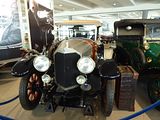
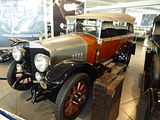
1909 Bianchi “tipo C 20-30 HP”: Born in Milan in 1865, Edoardo Bianchi founded the company that bore his name in 1885, when he was just 20. From the early production of wheelchairs, precision instruments, and especially bicycles (he was the first Italian who adopted “pneumatic tyres”), at the end of 19th century, he introduced the production of De Dion-powered cars. In the following years, the company started to produce motorcycles and trucks as well. In 1955, the company became part of a joint venture with FIAT and Pirelli, giving birth to the brand Autobianchi. On the car shows something new for the time: for the first time on this model, they adopted an electrical system for interior lighting, powered by a battery made up of glass pots full of distilled water and sulphuric acid. Other peculiarities are the original carbide headlamps, hand crank, the driver’s compartment separated from the passengers’ rear compartment, and, in addition, the upper part can be removed so that the car becomes a torpedo. Luciano Nicolis used to say: “This is a Bianchi I bought many years ago when vintage cars still were not a thing. They told me Counts Lada of Cremona owned it, it was parked under a porch and everyone thought it was an old carriage, but it was actually a luxury car. During WWI all cars were confiscated, my guess is that they detached the engine and the front and left it on that granary. The cabin was hidden behind other carriages so nobody could notice it. They said it didn’t work, they even broke the gearbox which was detached from the engine and hit it with a hammer to demonstrate it didn’t work. Maybe when the war was over they took it back outside but it was outdated and they abandoned it like old junk. Cars had become modern and even had electric starters. This Bianchi, had a luxury body and in summer you could take the top off and use a soft one, doors were similar to trains’ ones with curtains and cut crystal. In the rear there was also a little trumpet to speak to the driver who followed the passengers’ orders” In 1909 this car already had a battery for interior lighting, something new for the time. Accumulatori Torino built them. The carbide had a bad smell and was not suitable for interior use, while this electric one, with this glass pots, could do. Even this is an expression of great technology and modernity.
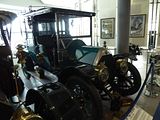
1915 Bianchi “Tipo S2”: The Bianchi S2 is the car which best reflects the aim of the company to build cars for less wealthy people. Thanks to its technical solutions and the introduction of this model, Bianchi proved once again to be a point of reference in the automotive world for the time. The car shown in the museum has a significant historical importance: it was used by the General Staff of the Italian Army during WWI to observe military operations: the letters S.M. that stands for Stato Maggiore (General Staff) are engraved on the front leaf-spring. The car has right-hand-drive according to a law provision whereby all vehicles had to stay on the extreme right side of the road in order to not frighten the horses and give the right of way to the other means of transportation. At the level crossings, since there were no barriers at the time, the driver had to stop the car and get off to check if there was a train coming and then get back in the car and drive off. The price of Bianchi cars varied from £4000 for the 2-seater to £14.000 for the limousine. Bianchi cars had large success not only thanks to the undoubtedly high quality of the materials and their refined design, but also their customer care. Included in the vehicle price there were a couple of days of driving school, every model was fitted with a tool box with a wrench, a tape roll and a hand pump. There was also a door-to-door servicing: specialized mechanics were sent throughout Italy’s Kingdom to repair the customers’ cars. They were paid £15 per day from the company and they also paid them the trip to the destination (second-class train ticket). Board and lodging was provided by the customer. Luciano Nicolis used to say: “All the cars were crank-started or push-started at the time, the hand crank was in front of the car, linked to the crankshaft, there was no other way, there was no electric starter. It was difficult and dangerous because the crank could slip from your hand and break your wrist. There still wasn’t the alternator in Italy: the magneto produced the electricity for the spark plug…”. The magneto was the first ignition system used in petrol engines.

1935 Bianchi “S9 Sport”: Introduced in 1934, the S9 was put on a market dominated by the Fiat 1500 and the Lancia Augusta, later replaced by the Lancia Aprilia. The streamlined body was offered with different bodies: sedan, coupe, and cabriolet version and a wide range of colours was offered as well. Among the characteristics of the car shown in the Museum there are the rear-hinged front doors, the typical “flag indicators” in the rear and tangent-spoked wheels. Near the driver’s seat, there is a crystal vase, where every morning fresh flowers were put and gave a pleasant fragrance to the interior. The Bianchi S9 was one of the most known models after the Giro d’Italia; this 1400 cc modified car, with no roof and sometimes no doors at all to intervene as soon as possible to change tires, was the flagship of Bianchi racing team. For many years this sedan followed and supported Fausto Coppi in his epic victories immortalized by sports reporters in many occasions that drew the history of this sport. The S9 will be the last Bianchi car. During WWII, in fact, the factory will produce bicycles, motorcycles and trucks for the Army. The building will be later bombed and the war was over the 4-wheel division, now producing trucks only, will become an autonomous reality thanks to a joint venture with Fiat and Pirelli in 1955: the Autobianchi.
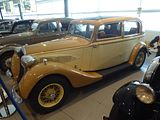
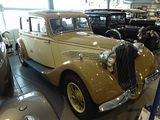

1956 BMW Isetta 300: The Isetta was introduced in 1953 by Iso Automotoveicoli Spa, a company founded in 1939 with the name Isothermos for the production of heaters and refrigerators. After the war, Iso started manufacturing motorcycles and scooters and later, in the ‘60s, fast GT cars powered by big American V8 engines. In Italy, the production of Isetta stopped in 1955, but the car kept being produced under licence by BMW, which sold it throughout Europe. The car on show is a German-built Isetta, also called motocoupé for its compact size. It had this odd egg-shaped body that resembled an helicopter and sufficient room for two people inside. The single front door was rather unusual, and the steering wheel and column were fixed to it. The Isetta in its Italian version became famous for the participation in the 1954 and 1955 Mille Miglia, winning in the special ranking related to performance in 1954.
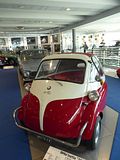

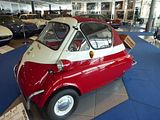
1974 Cadillac “Eldorado Convertible”: Antoine de la Mothe Cadillac was a French army officer who founded the city of Detroit in 1701. About two centuries later, in 1902 William Murphy and Henry Leland founded their car company in Detroit, already known as the American capital of automobile industry, and named it after the noble founder of the city. Cadillac cars soon drew some attention for their build quality and in 1909 the firm was taken over by the growing General Motors and it became, and still is, their high-end brand of the group. The Eldorado surely was the Cadillac model that contributed most to maintain a high image of the firm in the later post-war period. Introduced in 1953 in the convertible version and known all over the world especially in this version, the Eldorado was later produced also in the coupe version and, for a short period of time, four-door sedan. The car kept in the museum is a Mk 9 Eldorado, made from 1971 to 1978. This series will keep the front wheel drive layout introduced with the previous generation, and will be the last one to use big-displacement engines, such as the 500 ci (8.2 litres) of our model. In particular the 1974 Model Year introduced a new grille, new bumpers and taillights and updated interiors. It will also be the last Eldorado with fender skirts and front round headlights: the following year the rear wheel arches will be open and the front lamps will become rectangular.
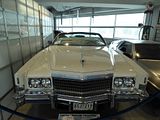
1930 Cord L-29: Errett L. Cord was one of the most innovative characters in the American automotive world of 1920s and 30s. Already owner of Auburn and Duesenberg, he decided to create a new brand with his name to launch a car for a higher market than the Auburn (US$ 1,000/1,500) but far from the astronomical prices of the Duesenberg (US$ 10/13,000). Surprisingly, he chose to build the new car with front-wheel drive, an innovative solution for 1929, that gave the vehicle an exceptional handling. The long Lycoming 8-cylinder engine was turned around, with the transmission placed in front of it. The elegant bodywork featured a narrow, pointed radiator grille, a long front bonnet and, due to the low, straight chassis, the interior space inside was considerable since there was no driveshaft running underneath the car. With a price of 3,095 US dollars, only 5,300 examples were sold: a lot of money for a revolutionary vehicle, but not much for an American automobile in that price range.

1903 Cottereau Populaire: Cttereau is one of the oldest French car manufacturers history, they produced their first car in 1898 in Digione. The Populaire model was powered by a single-cylinder engine couple with a 3-speed gearbox (with optional reverse gear!) rear brakes only and wooden rims. It had a double chain drive and manual lubrication via an oil dispenser near the steering wheel. There is no windscreen and the passengers had to were goggles and coats to drive, a usual practice in the early 1900s. The car shown in the Museum, probably the only model survived, won in 1979 the “International Grand Prix of Restoration and Preservation” and was the base model for the bronze sculpture at the museum entrance, made by the artist Annachiara Spellini. Luciano Nicolis used to say: “In the early days, automobile was a masculine word in Italian, probably because it was a vehicle that aimed to the male audience, then it became feminine thanks to Gabriele D’Annunzio that transformed the term with his famous quote: – The automobile is feminine. It has the elegance, slenderness and liveliness of a seductress; it also has a unknown virtue to women: perfect obedience. But on the other hand, nonchalant lightness in overcoming every roughness -“. According to commonplace women and cars won’t get along well together, but why is the connection so spontaneous? Just think about cinema or magazines, the car image is linked to the woman’s one most of the time. Women actually enter firmly into the factories during WWI to replace men who are fighting. This context helped creating the awareness of society’s role of women. During the post-war period many states will grant women the right to vote. Luciano Nicolis: “In the early days cars had to hide the engine inside a rounded compartment to give the same impression of power the known steam machine gave. Behind the radiator there’s a little single-cylinder petrol engine. The headlamps were powered by carbide. The car was replacing the carriage and the engine replaced the horses: something that amazed people back then. It had no doors or windscreen. The petrol tank is little and there’s also a manual oil dispenser. Reverse gear was usually an option. On the steering wheel there’s the hand accelerator. This car is called Populaire, despite not being that “popular” at the time: very few people could afford an automobile. It’s probably unique in the world and I’m very attached to it. So much so that I wanted a 1:1 scale bronze sculpture of me and my wife on this car placed at the entrance of the museum.”

1981 Delorean DMC12: John Z. DeLorean has been one of the most controversial protagonists of the automobile world between the ‘60s and the ‘80s. Young top manager at General Motors in Detroit, he always wished to make a car that would bear his name and his dream later became true. After founding the DeLorean Motor Company (DMC) in 1975 in the United States, in 1981 in Ireland he built, thanks to large loans from the English government, the plants where the first DMC 12s were produced. His dream vanished in 1982, when great difficulties and collected debts forced DeLorean to close the factory. He was even put in jail under the accuse of traffic of cocaine, although untrue. The car he created, the DMC 12, left a mark among the Grand Touring cars of those years, even though it was powered by a Peugeot engine that did not gave it huge performance figures. The chassis, which was designed also with the cooperation of Colin Chapman, founder of Lotus Cars, was fitted with a beautiful gullwing doors, and the body, styled by Giorgetto Giugiaro, was entirely made of brushed steel. The DeLorean became famous thanks to the 1985 movie “Back to the Future”, directed by Robert Zemeckis and starring Michael J. Fox and Christopher Lloyd.
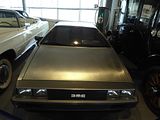
1924 Diatto Tipo 20A: The “Società Automobili Diatto-A. Clément” was born in Turin in 1905 by Vittorio and Pietro Diatto, sons of Giovanni Battista who founded a big company of railway material, later took over by Fiat in 1918. The Diatto oval badge, white lettering on a red background, appeared in 1909, after the Diatto brothers took over Clement’s participation in the company. It’s interesting to note the similarity between the Diatto and Bugatti‘s logo. During WWI Diatto built plane engines under Bugatti license and in 1919 launched a new car, the Tipo 30, made again under Bugatti license. Another prestigious meeting in Diatto’s history was the one with Alfieri Maserati, talented driver and founder of the homonymous company, that with the “20/S” model won many races and participated to the designing of the 8-cylinder Diatto racecar. In 1927 la Diatto participated with one of their cars at the first Mille Miglia, and in 1929 the company stopped making cars. The car displayed at the Museum is a formal family torpedo, with rear brakes only, a characteristic that will soon disappear after the late 20s. This is a very rare car as only a few examples exist today, you can count them on one hand.

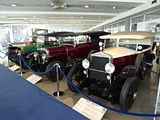
1925 Fiat “505 Coupé de Ville”: The Fiat 505 model was introduced in 1919, the same year of the 501, but it offered wider dimensions and higher cubic capacity. It fulfilled the requirements of more demanding clients looking for a more accurate bodywork. It was a royal car: it is proved by historical images that the Fiat 505 was used by the English Royal Family during a journey in Rome. The “coupé de ville” was basically a saloon body with the division between the front and rear compartment; if necessary, the driver’s compartment could be protected by a soft top. The car shown in the museum has some specifications which will become standard in the following 507 series, as the low-pressure tyres and the front brakes. Luciano Nicolis used to tell: “This car was sold in Milan in 1925 to a Count and was then bought in 1933 by a man living in Malavicina, in the Mantua province, who used it for his honeymoon. Then, as was typical in those days, due to economic problems, the car was cut and converted into a corn-picker, maintaining, however, all its rear part“. It entered the collection in 1972, after a scrupulous restoration to its original conditions.
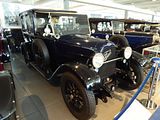
1926 Fiat “512 torpedo”: The 512 model substituted the then outdated 1919 501, even if the main characteristics were practically left intact. The real changes were made to the braking system and the suspension. Shock absorbers were added a well as brakes on all four wheels. The Fiat 512 had also a great success also abroad. Luciano Nicolis used to tell: “This example was found in the remote Philippines in the 1970s where its previous owner, Mr. Carl Gorge, had a number of business activities. He fell in love with the car and decided to restore it in to its original splendour. The vehicle was therefore sent to England where, over a period of about fifteen years, it was perfectly restored, maintaining many original parts like, for example, the mechanics and the instrumentation”. Then the car arrived in Italy and now it is displayed at the Museo Nicolis in Villafranca, Verona.
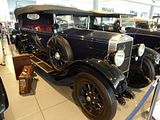
1921 Fiat 501 Torpedo: The 501 was the first car designed by Fiat after the Great War and the first step towards the economy car. Produced to fulfill the requirements of the average family, the 501 was cheap, robust and easy to maintain. It was successful all around the world thanks also to the wide range of bodies available: torpedo, roadster, landaulet, limousine, saloon, cabriolet, taxi, sports torpedo. The car shown in the museum, as the other 501 on display, is fitted with a torpedo body; it was probably the most popular version at the time. The body was slightly modified to widen the rear seats and create enough space for three passengers. It’s interesting to notice the license plate: VR 921. It is original but probably not the first registration plate. In fact, until 1927 the registration plate was only numerical: the first two numbers, in red, identified the province; the others, in black, was the car registration number. In 1927 the new alpha numerical system was introduced: the province was identified by letters (on this car VR stands for Verona) and the car registration numbering restarted from 1.
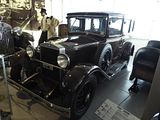
1925 Fiat “501 torpedo”: This car, made a few years later after the other 501 in the museum, is fitted with the “all weather” equipment which ensured some comfort to the passengers during winter time and in case of bad weather. Since 1925 the car was sold with optional expansion front brakes too.
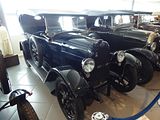
1924 Fiat 501S Superculasse Silvani: The reliability and strength of the 501 model remained unchanged in the sport version too, and were the basis for the car tuning. One of the most famous tuners was the Milanese technician Eugenio Silvani, who designed a new cylinder head just for the 501 model, moving the vlavetrain from side valves to an over-head valve layout. The famous “Superculasse Silvani” cylinder head was sold as a performance kit with all the gaskets, manifolds and valve shafts necessary to replace the stock head; it spread largely thanks to its ease of installation. The “Superculasse Silvani” gave the engine more power, acceleration and torque. The Fiat 501 S shown in the museum was apparently ordered by the Fiat agents in Bombay for the maharajah of Patiala and is fitted with the “Superculasse Silvani” head. The body has been rebuilt in the Seventies.
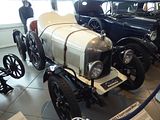
1927 Fiat 509A: An example of popular car, the 509 was presented in 1925 and updated in 1926 with the “A” version to fix some mechanical issues immediately highlighted. The 509A had a wide spread, thanks also to the variety of bodies offered, among them the Weimann sedan. This type of flexible body was patented in France by Charles Torres Weymann and allowed to build lighter and soundproof bodies than the traditional ones. It was based on a light frame, fixed to the chassis with rubber supports, and was covered by an oilcloth and by a jut cloth which was covered with leatherette (pegamoide). This system had a big spread during the 20’s and the patent was purchased by many automobile companies and by many private coachbuilders; the largest limits of the Weymann system were the poor shock resistance and the need to adopt rather squared lines for the bodywork. The car shown in the museum is kept in its original and still well-preserved conditions, as you can see by its wooden frame, the basis of the Weymann patent.
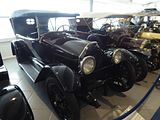
1933 Fiat 508 Balila: Fiat called the model 508 “Balilla” to celebrate the fascist regime. It was the name given to Italian little boys who, in Mussolini’s mind, were supposed to demonstrate the same courage of the young Giambattista Perasso, nicknamed Balilla, showed when he rebelled to the French invasion of Genova. The 508, was introduced at the 1932 Milan Motor Show. Sold at the amazing price of Lire 10.800, it immediately became the car of the collective imaginary: affordable, small but comfortable and a good all-rounder. It was fitted with a 3-speed gearbox and was offered with different types of bodies (2-door sedan, torpedo, spider, van); the first deliveries began on July 15th, 1932. The 2-door saloon, as the one shown in the museum, had 4 comfortable seats, cloth interior, bright paint, wide doors with manual lowering windows, rubber mats, electric windscreen wiper and a rear view mirror. Offered as options, you could purchase: special cloth, chromed headlights, handles and bumpers. Other extras were available, like back stop light, clock, ashtray, back trunk, a second spare wheel, wire wheels and leather interior. The Fiat Balilla is known to the public for its appearance in the torpedo version on Roberto Benigni’s movie “Life is Beautiful”


1947 Fiat 500A “Topolino”: In 1934 Fiat gave the designers Antonio Fessia and Dante Giacosa the important job of designing a new small popular car. Two years later the “500” was born, the smallest production car ever produced, with a tiny 569cc engine . Commonly known as “Topolino” (Mickey Mouse), this new car was inspired by the design of her big sister, the 1500, introduced the previous year. Weighing just 535 kg and with independent wheels all around with transversal spring, the 3,21-meters-long Topolino offered the same comfort and performance of a higher class car. The Topolino, sold at Lire 8.900, was Fiat’s answer to the national request for a popular car within the reach of the middle and lower Italian classes. Initially offered in the sedan, convertible, and van version, the 500A was later produced in two other series, B and C, with styling and mechanical modifications, until 1954 for a total of about 520.000 cars, and it was the first real Italian example of mass motorization. The Fiat advertisement read Fiat: “I have got the automobile too. Fiat 500, the great little car“. Luciano Nicolis used to say: “I found this car in Turin and they told me it was owned by the secretary of Vittorio Valletta, the president of Fiat“.

1950 Fiat 1100E Cabriolet Visotal: At the end of World War II, Fiat restarted the production of the 508 C Nuova Balilla 1100, now more simply called 1100 B; in 1949 they modified some exterior features and fitted a rear boot lid: the new model was called 1100 E (and L for the long wheelbase version, Italian taxi drivers’ favourite car). The E was the last 1100 model with separate chassis (the 1100/103 presented in 1953 would have been a more modern monocoque), the E was dressed by many Italian coachbuilders in different versions (sedan, cabriolet, roadster, station wagon and utility van too). The car shown in the museum is a one-off creation by one of the most well known coachbuilders, the Carrozzeria Castagna of Milan that during the years between the two World Wars became famous all over the world thanks to their elegant designs on prestigious chassis, like the body fitted to the Isotta Fraschini Tipo 8AS shown in the museum. This cabriolet is called “Vistotal” for its particular windscreen fitted without side supports, as patented in 1936 by French coachbuilder Labourdette with the name “Vutotal”: it allows a total visibility of the road in front of the driver. This spider is one of the last creation of Castagna and stands out for the attention to detail. The transparent steering wheel is on the same wavelength as the windscreen, a work of art only fitted to luxury cars.
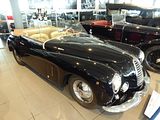
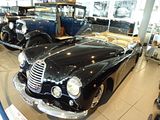
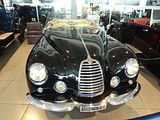
1954 Fiat 1100 Tipo 103: Introduced at the 1953 Geneva Motor Show, the 1100/103 marked the end of the period started with 508 Balilla and opened the way to one of the most popular and fortunate models of the Turin company. The 1100/103 model was the first of along series of 1100s that will be produced until 1970 with stylish and mechanical updates, until 1970. It got rid of the traditional body-on-frame for a more modern monocoque. The style reflected the styling trends of the period with a modern 3-volume body. Offered in two versions, the more spartan A type and the more refined B type with a bench seat in the front and heater, like the car of the museum. The 1100/103 was sold at an attractive price in accordance with the market expectations. Strong and reliable, the car had a considerable success and, on the Italian market, rivaled with the faster Alfa Romeo Giulietta and the more elegant Lancia Appia. Luciano Nicolis used to say: “This car drove around Villafranca, it still has Verona license plates“
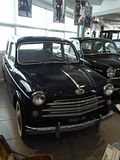
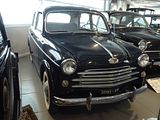
1965 Fiat “600 D coupé”, Viotti: “The most modified car by the Italians”: borrowing a similar expression from a famous italian advertisement, that’s how we could define the Fiat 600, the Italian dream of the post-war years. Born as an entirely new project, with an water-cooled rear engine and four comfortable seats, the 600, together with the Balilla and Topolino, was the car that motorized the “Bel Paese”.
The 600 was also the most transformed and personalized Italian car by coachbuilders and tuners who gave free rign to their creativity and definitely launched the Italian style in the world. The car in the museum is a 750cc version of the 600, whose engine displacement was increased to widen the performance gap from the 500 model in 1960. This little coupé with a cloth sunroof was designed by Viotti, a coachbuilder established in 1921, whose name is linked to the production of several one-offs on Fiat and Lancia chassis, and to the diffusion in post-war Italy of a new type of body: the station wagon, at that time called more simply “giardinetta”. This car was fully restored according to the original specifications.
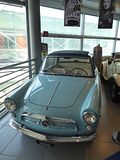


1923 Ford Model T Snow Machine: The car shown in the museum is probably the best proof of the Ford T “universality”: it could be really ordered with those optional and specifications more useful for buyers. This is certainly one of the first example of a car that could be driven safely on the snow, by replacing, in a few minutes and by a few tools, the front wheels with two practical skis. During the Model “T” 19 years of production, not less than 5.000 different kinds of optional were offered: from the ones for the engine (several types of ignition and carburettors) to the ones for the other mechanical parts (more or less comfortable suspensions, radiator leather or fabric cover) to the ones for the passenger’s comfort (different interior materials, several heating systems).
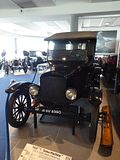
1956 Ford Thunderbird: The Thunderbird series was the Ford reply to the Chevrolet Corvette; unlike the “Vette” , since the beginning of its production, it was fitted with the V8 engine, available in various horsepower levels. While the Corvette was the sports and essential car, the Thunderbird, fitted with electrical windows and adjustable seats, offered luxury and comfort to its two passengers. The modern body style was enhanced by the “panoramic” windshield (particularly in fashion at that time in the United States and later dropped because of the optical distortions it created) and by the rear fins that, in the following series, had much larger and exaggerated dimensions. The bonnet convexity allowed to lodge the 4-barrel carburettor of the most powerful engine, giving 285 bhp. The car shown in the Museum is of the series, produced from 1955 to 1957, nowadays more appreciated and sought after by the collectors, especially for its clean and compact line.
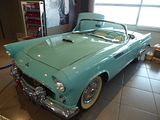
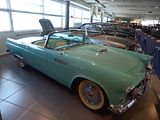
1967 Iso Rivolta IR300: Isothermos was founded in 1939 for the production of refrigerators and heaters. After the war their production turned into motorcycles and the company name changed in Iso Automotoveicoli Spa. In 1953 they presented the famous Isetta, the little two-seat car that had a lot of success in Italy and in Europe, where it was manufactured under Iso license by other car industries (such as BMW in Germany). In the 1960s the firm started producing fast Grand Tourism cars that united the Italian style and manufacturing technics with the high performances guaranteed by the big American V8 engines in one car. Designed under Giotto Bizzarrini direction, the Rivolta GT IR 300 prototype was introduced in June 1962. With an elegant body designed and constructed by Bertone, this car started being produced in 1963 and was the Grand Tourism car that had the greatest commercial success for the factory.

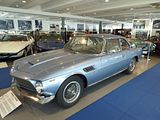
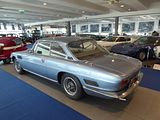
1929 Isotta Faschini Tipo 8 AS: The “Società Milanese d’Automobili Isotta Fraschini” was founded in Milan in 1900 by a group of passionate and wealthy people, including Cesare Isotta and Oreste, Antonio and Vincenzo Fraschini brothers. Created only to be agent and dealer for some foreigner car firms, Isotta Fraschini started very soon to build their cars, becoming doubtless the most prestigious Italian luxury car industry: the Tipo 8, presented in 1919, was one of the first production cars in the world fitted with a straight-8 cylinder engine. The Tipo 8 is a myth in the automobile world : produced only as a rolling chassis (IF never built bodyworks), it was fitted with the most elegant and luxurious bodies of the best coachbuilders. Each car was different from the other and has its own history, its own personality, its own exclusive beauty. The dimensions were monumental; the interior were sophisticated lounges lavishly decorated with crystal, silver and briar and upholstered with elegant Damasque cloths. On the Isotta Fraschini nothing was lacking to ensure maximum comfort: from the lady’s vanity case with the adjoining “maquillage corner”, to the gentleman’s set with its “moustache curler”. The headlights were a masterpiece in grinded crystal and all their parts were numbered. The car shown in the museum comes from Pennsylvania, USA, and it was owned also by the poet Gabriele D’Annunzio’s son, Veniero, who was Isotta Fraschini agent in the United States. For 12 years Luciano Nicolis devoted considerable efforts to restore this car to its original condition. The restoration result is under visitors’ eyes: a masterpiece worthy of a legendary car (the interior were looked after by a well-known Italian stylist).
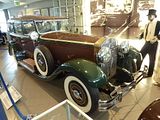

1920 Itala Tipo 50 25/50: Established by Matteo Ceirano in 1904, Itala lived its best period in the years before the Great War both for the victories achieved at races, such as the Targa Florio, and for the triumph at the famous Peking-Paris Raid with a Tipo 35/45HP driven by prince Scipione Borghese, a trial that became a legend in the automobile racing world. At the 1911 Turin Motor Show, Itala introduced the first Italian sleeve-valve engine car (produced in several models until 1917) and during the war the company was forced to convert the production into war material. One of the first model produced after the end of the war was the “Tipo 50”, designed by engineer Alberto Orasi. By looking at the car in the museum, it can be noticed how 1920s cars began to look more modern: the electric lights replaced the carbide ones, and the brass finishing were replaced by the nickel-plated and later chromed ones. The starting handle was not eliminated, but carefully hidden: really the starter had not yet reached a level of reliability to ensure the constant car starting.
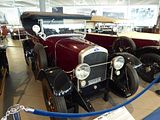
1969 Lamborghini Espada 400GT: Presented in Geneva in March 1968, the new Espada aroused a great deal of interest due to its highly innovative and extremely aerodynamic line, then defined as “artistic”. It was produced to compete with the spacious and wonderfully comfortable coupé vehicles that Maserati with the “Mexico” and Ferrari with the 365 GT 2+2 had already put on the market, even if it was technically less refined. Starting with the platform of the “400GT“, the Lamborghini vehicle had enormous personality; the mechanics, except for the pitch which had been extended by 15 cm, were the same as the 400 GT, including the V12, 3929cc engine, although the power had been slightly raised (325hp). The finishing was also more exclusive (the entire interior was upholstered in leather, including the dashboard). The Naca ducts on the bonnet were reminiscent of aeronautical solutions and it had rear-wheel drive. Because of the original fast back roof with the rear window divided into two parts, the car, despite a rather poor development in height, had 4 separate seats. From 1970-71 the second series was further developed by substantially changing the interiors that Gandini had already designed. A VIP version with a fridge-bar and television screen was also available
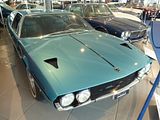
1911 Lancia Beta 20HP : This car was born in 1911, when one of the most fascinating history periods, the Belle Epoque, is nearly over. In fact, after just three years, WWI will begin, wiping out dreams, illusions, wealthy, art and millions of lives. It’s a Beta built on the B-type long frame, sold in America as a simple chassis, a common practice at the time to pay fewer custom duties. It received a runabout body (an American term that corresponds to our spider) built by SGV coachbuilder. Among the most evident peculiarities of this model there is the twin accelerator (both pedal and hand accelerator on the steering wheel) and the big 100-liter fuel tank on the back. At the time gas stations were rare and gasoline could be bought in cans at the general store, therefore you needed a good range. On the left side there’s a brass jerry can where you could store more gas. Attentive to innovations and customer necessities, in 1909 Vincenzo Lancia fitted his cars with a full spare tire, not only the tire like the majority of cars in Italy. On this car you can also notice the big acetylene headlamps and the mechanical speedometer on the front right wheel, probably fitted in the US. Luciano Nicolis used to say: “This is an SGV, with Lancia frame and American body. This oddity is probably due to the custom duties of the time, very high for cars. In this way, it was possible to save money. At the time buying the chassis and engine from a car company was a common thing at the time, the nit was shipped abroad and put together there to pay fewer custom duties (see the history of Italian custom duties). The body fitted in America followed the styling of the time. The body was indeed quite modern and many cars were fitted with similar ones (see the Peking to Paris) …. Since it was a sports car that had to travel for many miles, it had a spare can. It already had the spare wheel with the rim attached, not just the tire as many others. There were two additional oil headlamps in the absence of acetylene. Acetylene headlamps were more powerful and were made with cut glass, so that the glass didn’t crack under the effect of heat. The 4-cylinder engine was quite large and was made in a single block, not twin block”.
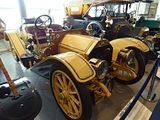
1930 Lancia DiLambda Coupe de Ville Castagna: The 5-metre-long Dilambda was Lancia’s flagship until 1931, when the Astura was introduced. Initially designed for the rich American market, the car was modified for the European market and unveiled at the 1929 Paris Motor Show. Unlike the monocoque chassis of the Lambda, the Dilambda had a classic body-on-frame structure, with independent front axle and powered by a V8 engine derived from the previous Trikappa. The Dilambda chassis was appreciated for its driving performance, comfort and quietness. It was adopted by the major independent Italian coachbuilders (Pinin Farina, Castagna, Cesare Sala, Stabilimenti Farina) and abroad, to create beautiful bodyworks able to fulfill every need, as the Castagna coupé de ville shown in the museum. It was subject to an accurate restoration to recreate the interior’s warm and elegant atmosphere of those years.
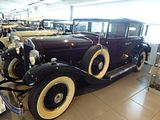
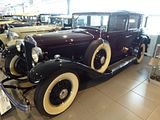
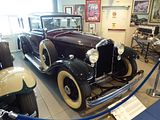
1933 Lancia “Artena II serie” coupé de ville, Cesare Sala: The Lancia Artena (the same name as an old Lazio village) was introduced at the 1931 Paris Motor Show: the Artena and its older sister, the Astura (presented at the same event) replaced the Lambda and Dilambda models on the market. The Artena was a more traditional car with a separated chassis, derived from the Dilambda one, updated and more comfortable; a chassis destined to be clothed by independent bodybuilders according to the customers’ requirements. Although it was fitted with strong and reliable mechanics that guaranteed adequate performances, the Artena was not able to reach the commercial and image success of the Lambda, also because it was dimmed by the more important and prestigious Astura. However, the Artena was produced until 1940 in four series for a total of over 5.500 cars. The Artena on show in the museum is a coupe De Ville of the renowned Carrozzeria Cesare Sala (a car destined to be chauffeur driven), which conserves many integral and original details, including the log book and registration plate.

1938 Lancia Astura Spider Mille Miglia, Colli: Although it was created to be the Lancia luxurious flagship car, the Astura was often raced by private drivers. The car shown in the museum was prepared in 1939 by Carrozzeria Colli, by order of the Milanese Scuderia Ambrosiana, for one of the Scuderia top drivers: Luigi Villoresi. The car, whose engine gave 110 bhp compared with 82 bhp of the series version thanks to an experimental hemispheric cylinder head similar to the one of the new Aprilia, was entered to the Mille Miglia, but unfortunately Gigi Villoresi had a road accident during the running in of the car and so he could not participate in the race. In the post-war years, this car was raced by several Italian drivers, among whom Franco Cortese who gained the highest success, before being sold to the English drivers John Gordon and David Lewis who drove it at the 1949 Mille Miglia. Ended its race career, the car was used for much less noble actions: the smuggling of precious watches from Switzerland to Italy. Seized by the Swiss police, for many years the Astura remained forgotten in a warehouse, where it was rediscovered by Luciano Nicolis who brought it to Italy and had it restored in order to proudly use it at the most prestigious classic car events.
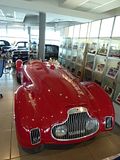


1942 Lancia Aprilia 1500 Serie II: With its revolutionary style, innovative technics and high performance, the Aprilia, represented the highlight of the period technics. It was a compact car, but it was also able to guarantee maximum comfort even for five passengers. Low, with the headlights placed on the still separate wheel arches, the windshield that joins the roof with a single unbroken line and receding tail, the Aprilia gave that visual impression of speed that it really had. Vincenzo Lancia was particularly impressed by the results, but unfortunately he could not enjoy his latest success as he died a few months after the presentation of the car in 1936. The car was also built in France in 1937 and 1938 with the name Ardennes. Monocoque, like the Lambda in 1922, the Aprilia body has the typical folding doors without B pillar, and its refined mechanics have independent suspensions at the rear too. A very original feature of the car shown in the museum is represented by the two separated sunroofs, for which it was called “the gangsters’ car”. Actually, this was a technical solution due to the body structure itself.

1947 Lancia Aprilia Speciale: Both the first and second Aprilia series were produced with different wheelbase chassis in order to be fitted with different types of bodies or be sold as rolling chassis for the independent bodybuilders. All the most important Italian bodybuilders (Bertone, Touring, Vignale, Pinin Farina to name a few) created beautiful bodies for the Aprilia, which sometimes looked like a small Astura. In the 1930s, the showy and luxurious American style had influenced all the Italian and European bodybuilders, who after the war came back to a more linear elegance represented by the “pontoon fender” bodies, which integrated the fenders in the car line eliminating the deep modelling that had marked the previous style. The car on show in the museum was designed by Pinin Farina on a Type 439 long chassis. From this creation you can notice the evolution of the style with the headlights becoming a part of the front end and the disappearing side footboard. The natural evolution of this style would later lead to the creation of the Aurelia. The Aprilia was a beloved and appreciated successful car, its production was stopped in 1949.

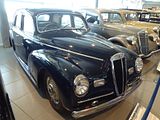
1941 Lancia “Ardea I° Serie”: The Lancia Ardea stemmed from the need for a smaller and cheaper alternative to the Aprilia. The result was a 9/10 scale model of the big sister, with the same design, very streamlined for the time, but also the same technical solutions, mantaining the typical Lancia’s class and refinement intact. The Ardea was powered by a V4 engine with overhead camshaft, driven by a chain and automatic tensioner (patented by Lancia) and hemispherical combustion chambers. A truly sophisticated engine for the time. The traditional monocoque chassis was also taken up. Museo Nicolis’ Ardea is a Mk1 car from 1941, with a 6 Volt electrical system and instead of the fully-opening trunk as found in the Aprilia, there is a little door for the spare tire behind the rear plate. Another interesting detail is the door opening with no B pillar, a styling cue Lancia will later keep, and the stylized spear on the top of the hood that opens it if you twist it. The Ardea will live a long life also thanks to the van version that will be produced up until 1953, reaching 22.730 total specimen and leaving room for her heiress: the Lancia Appia.
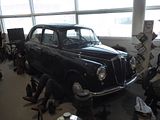
1957 Lancia Aurelia GT Coupe B20 Serie VI: Introduced at the 1951 Turin Motor Show, the Aurelia B20 is undoubtedly one of the most appreciated and known Italian Grand Touring cars in the world. The V6 engine derived from the one first presented in 1950 and fitted to the B10 saloon. The beautiful body, which surely influenced the design of many other period sports cars, was built by Pinin Farina and showed the Lancia concept of elegance, discretion and above all high quality. The B20, the sports car to drive wearing a double-breasted jacket, had a long and successful racing career both the factory prepared “racing” and “special” versions, and with series cars which the owners drove in race as in daily life. The B20 race debut at the 1951 Mille Miglia is legendary: first in the up to 2-litre class, and second overall behind the 4-litre Ferrari driven by Gigi Villoresi.
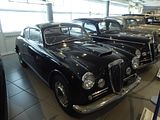
1954 Lancia Appia Berlina Serie 1: The heir of the Ardea, the new “little” Lancia Appia was presented at the 1953 Turin Motor Show. The head valve distribution was controlled by two camshafts. Fed by a Solex carburetor, the engine produced 38 bhp, which gave the new sedan higher performance than its main competitor, the Fiat 1100/103. The body recalls the style of its older sister, the Aurelia, with rear-hinged doors and no B-pillar. The car was carefully finished, with the quality of a higher-class car. In those years there was a boom for small cars which marked the emancipation of the working class, now freed from the wartime restrictions. In this context, the Appia was an arrival point for the up-coming middle-class that wanted to be distinguished and saw Lancias as classy cars with high performance. In 1955 the Appia Mk.I was replaced, but the model remained in production, followed by two series, until 1963; the Zagato bodied sports versions won many races in the 1100 class.
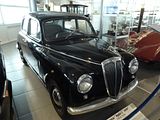
1960 Lancia Flaminia Berlina: The Flaminia, presented at Turin Show in 1956, was Lancia’s great flagship, the heir of the Aurelia. It was designed by Professor Fessia. Sold at extremely high prices for the thime and therefore with a rather low number of vehicles produced, it was still a top symbol of Lancia production in the post-war period and represented a flagship for that segment which is now defined as high quality constructions and large, luxury saloons. There is room for six people to sit comfortably in the large driver and passenger compartment. Worth nothing are the two small fins on the back which, although influenced by the American style, were re-interpreted more elegantly by Pininfarina who took charge of the aesthetics. Due to its stateliness and aristocratic line (4.85 m long and 1.75 m wide), this vehicle became the car of statesmen and industrialists during the economic boom.
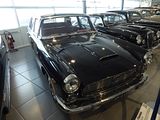
1965 Lancia Flaminia Farina Coupe B 2.8”: Introduced at the 1959 Turin Motor Show, the Flaminia Coupè got back to the saloon aesthetical features, but on a 2.750 mm shortened chassis. Its style, clean and lacking in the American stylistic excesses very common in Europe at that time, was designed by Pinin Farina, who later chose a Flaminia Coupè as his personal car. Like the other sports versions, built by Touring and Zagato, also the Pinin Farina Coupé was fitted with the Flaminia sports engine, initially of 2.5-litre capacity giving 119 bhp. The script on the car shown in the museum, Coupé 3B 2.8, specifies that it is fitted with the 2775cc 3-barrel carburettor engine. We let you note that on this form the name Battista (Pinin) Farina is written in two different ways: this because in 1961 the famous bodybuilder got the permission to change, thanks to a decree of the Italian Republic President, his family name from Farina into Pininfarina, the name under which his creations were known all over the world. This is why the visitor can read the name Pinin Farina on the cars designed by him until 1960, and the name Pininfarina on the ones designed later on.
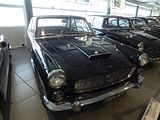
1960 Lancia Flaminia 3C 2.8” Convertibile Touring: The Flaminia saloon, heir of the Aurelia model, was introduced in its definitive style at the 1957 Geneva Motor Show. Inspired by Florida, the one-off coupe designed by Pinin Farina on the Aurelia chassis, the new saloon, which abandoned the traditional Lancia design of the 1950s, entered the higher market level, that of the luxurious cars. As well as the Aurelia, also the Flaminia series had its sports versions, which were bodied, upon decision of the Lancia top management (Gianni Lancia, heir of the company founder, was no more on charge at that time), by the most important Italian bodybuilders: by Pinin Farina the long chassis elegant coupe, by Zagato and Touring the short chassis sports coupe. At the 1960 Geneva Motor Show, Carrozzeria Touring introduced the Convertible, derived from the elegant GT coupe; the car shown in the museum is fitted with the last evolution of the Flaminia sports engine, with the capacity increased to 2775cc giving 150 bhp. Also the Flaminia Convertible was built with the traditional “Superleggera” system (that is a steel tube frame to which the body aluminium panels were fixed) which made Carrozzeria Touring famous all over the world
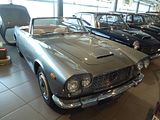
1965 Lancia Flaminia Super Sport Zagato: The Lancia Flaminia Zagato Super Sport unites two of the oldest and most esteemed names in the Italian motoring industry. The outcome and the combination, especially in the Super Sport form, is a fair tribute to both companies. On 4th November 1964, when the Turin Show had already begun, the Lancia exhibited a new model, the Flaminia Super Sport, at its stand, which happily brought the evolution of the prestigious Coupé Flaminia to a close. Elegant and sporty at the same time, the Super Sport appeared stylistically extremely pleasant with substantial modifications to the bodywork compared to the previous model. The most apparent of said modifications was in more stubby tail, which maintained the same circular optic groups as on the previous model but inserted into a cavity with a greater diameter at the edge of the lateral curve of the tail. The front also had a new design. While maintaining the now traditional Lancia style of the radiator cowling, it had better aerodynamic profiling and connected nicely with the drop slot of the plastic-covered headlights. The interior fittings were of the highest quality and the seats had a new anatomical design. The boot had a hatch that communicated with the driver and passenger compartment for the easy transport of a golf caddie or skis, a solution that is quite common nowadays, but totally unusual at the time. Compared to the previous Sport versions, the Super Sport was generally more elegant and “touristic“.
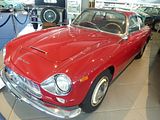
1921 Lorraine-Dietrich “ B 2.6”: The De-Dietrich Group was established in 1880 in German Alsace; in 1919 after the Treaty of Versailles, both Alsace and Lorraine became French. The company started with the production of railway carriages, adding soon the cars and, from the beginning of the Great War, the aircraft engines production. Until 1918 the cars were produced with the De-Dietrich name, but later the company changed it into “Lorraine-Dietrich” and adopted a new badge: a Lorraine cross on a blue background with two white storks at the side. The B 2.6 model, produced only in 1921, was the first example of a series which remained in production, with the B 3.6 name, until the early Thirties. Sold at a reasonably low price targeted for the large middle class market, the tourer version, like the one shown in the museum, slightly recalled the American style prevailing at the time, but with the typical specification of the middle class French cars of the Twenties: electric headlights and starter, and nickel-plated finishing. The B 3.6 sports version, able to reach 150 kph, won the 1926 Le Mans 24 Hours.
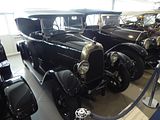
1958 Maserati 3500 GT: The first mass-produced Maserati Grand Touring car, the A6 1500, was introduced in 1947, after the firm had been moved to Modena following the acquisition by Cav. Adolfo Orsi in 1937. At the 1957 Geneva Motor Show, Maserati introduced the 3500 GT, an elegant and powerful coupé designed by Carrozzeria Touring. Updated during the production years with front disc brake, 5-speed gearbox, indirect fuel injection system, the 3500 GT was a great commercial success and was built in an uncommon number of examples, considering the period and its sports specifications.
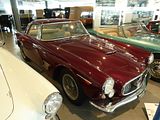
1960 Maserati 3500 GT Spyder Vignale: Introduced in 1957, the 3500 GT coupè of the Touring body-maker was a great commercial success for the trident firm and so it seemed obvious to accompany the coupe with a spider version. Designed by Giovanni Michelotti (one of the most active post-war Italian designers) and produced by Carrozzeria Vignale, the spider was built on the shortened frame of the coupé version, coupe loom 100mm shorter, was introduced at the 1959 Turin Exhibition already with rotating front breaks that were to become standard starting from 1960.

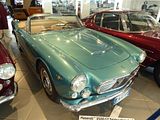
1962 Maserati 3500 GTi: The first mass-produced Maserati Grand Touring car, the A6 1500, was introduced in 1947, after the firm had been moved to Modena following the acquisition by Cav. Adolfo Orsi in 1937. At the 1957 Geneva Motor Show, Maserati introduced the 3500 GT, an elegant and powerful coupé designed by Carrozzeria Touring. Updated during the production years with front disc brake, 5-speed gearbox, indirect fuel injection system, the 3500 GT was a great commercial success and was built in an uncommon number of examples, considering the period and its sports specifications.

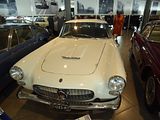
1968 Maserati Mistral: Following the commercial success of the 3500 GT Touring, Maserati launched a new 2-seater coupé at the 1963 Turin Motor Show. Designed by Frua, the new Mistral anticipated some styling innovations like the hatchback or the integrated front bumper with the front grille inside, that will be adopted by the other car manufacturers years later. The engine displacement raised from 3500cc to 3700 cc and in 1966 an optional 4-liter engine was available as well. Sold up to 1970, the Mistral is the last Maserati GT car with an inline engine, a true strong point of the Modenese brand both on track and on the road.
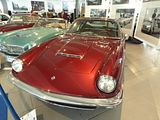
1971 Maserati Mexico: Maserati introduced at the 1965 Turin Motor Show a new 2+2, named 5000 GT, whose elegant body had been designed and built by Carrozzeria Vignale in Turin. The new model offered four real seats to those who were looking for a sports car with comfort and habitability. In 1966 the production of the series car, named Mexico, with both the 4.2-litre and 4.7-litre engine. The Mexico engine was derived, just like the 5000 GT’s (made in just 33 examples between 1959 and 1964) and the Quattroporte’s (introduced at the 1963 Turin Motor Show), from the 4.5-litre V8 unit previously fitted to the 450 S, the most powerful sports car ever produced by the Trident firm and did not win the 1957 World Makes Championship because of an incredible series of negative circumstances. The name Mexico derived from the Cooper T81 that won the 1966 F1 Mexican Grand Prix with a Maserati engine under the hood.
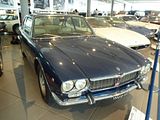
1972 Maserati Ghibli: Exploiting the success of the V8 engine, fitted both to the Quattroporte and Mexico, in 1966 Maserati presented at the Turin Motor Show the most sports version of their range, a sleek 2-seat coupè which in the name recalled its exciting performance: Ghibli, the desert wind. Designed by Giorgetto Giugiaro and built by Carrozzeria Ghia, the Ghibli is believed one of the most beautiful example of the Italian styling of the Sixties: the engine position, in the front and very low, thanks to the dry oil sump lubrication, allowed Giugiaro to design a low, sports but at the same time elegant body which had a great sale success. Produced in both 4.7-litre and 4.9-litre engine version (the latter called Ghibli SS), both coupé and spider, the Ghibli could be fitted on request with the automatic transmission too. The car shown in the Museum has had two owners prior to be acquired by Luciano Nicolis and has covered just 41,700 kms: its leather interior are still the original and allow to appreciate the constructive care which the Trident firm put on every detail of their cars.
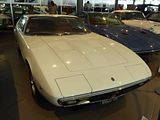
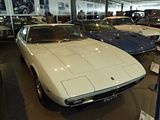
Maserati Indy 4700 “America”: Driven by Wilbur Shaw, the Maserati 8 CTF won the 1939 Indianapolis 500 and Maserati was the first European (and Italian) car company to win it after Peugeot in 1914. The little Bolognese firm succeeded in what Fiat, Mercedes, Alfa Romeo, and Bugatti failed to. The same car, driven again by Wilbur Shaw, won the 1940 edition too and entered the automobile legend as the first car that won the most important American race twice in a row. To remember these triumphs, Maserati called “Indy” its new 4200 cc car introduced at the 1968 Turin Motor Show. The Indy was the obvious evolution of the Mexico, a fastback coupé with enough room for four people. During the production years, the most important modifications concerned the engine; in 1970 it was enlarged to 4.700 cc and the car got the name Indy America; from 1973 on, only the 4.9 litre version (the same unit already fitted to the Ghibli SS) remained available. The Indy was a good commercial success and kept being produced under the new Citroen administration that later took over the Modenese company.
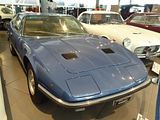
1934 Mercedes-Benz 500K: In 1926 Daimler (which produced cars with the Mercedes brand) and Benz merged to establish Daimler-Benz. The adopted name and logo (the Mercedes-Benz writing on a round badge with the Mercedes three-pointed star framed by the Benz laurel crown) have always marked prestigious cars. The 500 K was first introduced in 1934: the 5-liter engine was able to give 100 bhp without supercharger; the Roots supercharger raised the power to 150 bhp and the car could reach 160 kph. Mercedes-Benz had a special body department at the Sindelfingen plant and most of the 500 Ks and later 540 Ks were fitted with factory-built bodies rather than bodies built by independent coachbuilders. The car on display at the museum is fitted with a cabriolet C body: a two-door cabriolet, with two side-windows and four/five seats. This car was probably used by some representatives of the Third Reich government and in 1936 it was updated with the bigger 540 K engine; the 5.401cc engine was able to develop 180 bhp at 3.400 rpm. Luciano Nicolis used to say: “This is a 1934 500K, probably one of 8 cars that came back to the factory to be updated as 540Ks. So this is basically a 540K. It’s a truly rare car, it still reaches 180 kph. Back when it was produced in 1935, it was very sought-after by party officials and lords. On German magazines they said its only rival was Rolls-Royce. As an Italian, I would say Alfa Romeo and Isotta Fraschini could compete with this car too”.
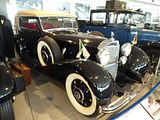
1956 Mival “Mivalino 175: In the early ‘50s the so-called micro cars had a large diffusion in Europe. These were curious little cars with three or four wheels and able to carry two people and their luggage. They usually were fitted with a motorcycle engine and therefore, to many people, they represented the first means of transport after the motorcycle. As the Italian Isetta was manufactured abroad under licence (i.e. in Germany by BMW), even cars designed abroad were then produced in Italy under licence. It was the case of this little car that the Mival of Gardone Valtrompia started producing from 1953 under licence of the German Messerschmitt, the famous aircrafts manufacturer which after the war converted its production to popular cars. The KR 175 and later 200 (or Mivalina, as called in Italy) showed the feature of the two-seats in tandem: the transparent roof made the little car look like a fighter airplane cockpit.
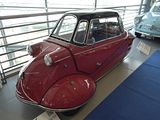
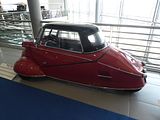
1951 MG TD: Morris Garages Ltd was the Morris dealer in Oxford and, as well as the firm, was owned by William Morris. They were specialized in manufacturing special bodies for Morris cars, especially for Oxfords and Cowleys. In 1922 Cecil Kimber became general manager of Morris Garages and greatly contributed to the foundation of MG (i.e. Morris Garages) as an independent company, even though in close cooperation with Morris. The production of the very first MG car can be traced back in 1925. Unfortunately in the 1980s, this glorious marque disappeared, while the MG brand kept being used by Rover for their sports cars. Introduced in 1949, the TD model is one of a series of small sports cars, the Midgets, that started in 1936 with the TA and ended in 1955 with the TF. Still inspired by the 1930s style with very long wheel arches, small doors and big headlamps, the car has a handmade wooden dashboard and other details typical of that period. The car shown in the museum is still in its original condition.
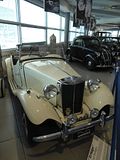
1903 Oldsmobile Curved dash: Founded by Ransom Eli Olds in 1897, the Oldsmobile is the oldest American automobile industry; in 1904 Olds left the company to found the REO, and in 1908 the Oldsmobile firm was purchased by William C. Durant and it became part of the newborn General Motors Company. The Model R Curved dash runabout was introduced in 1901: simple, economical and practical had an immediate success and remained into production until 1903; it can be surely considered the first mass produced car in the world. The light wooden bodywork still shows specification resembling a horse carriage rather than a car: at the rear plate sides there are the supports to fasten the horses to be used in case of need, while the basket on the passenger side, today used as an umbrella stand, originally contained the riding whip. To notice the characteristic steering control: a long bull tail shaped lever.
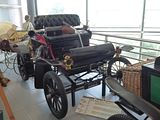
1929 OM “469 S”, Schieppati: The Società Anonima Officine Meccaniche (OM since 1928) company was founded in 1899 with the merger between two locomotive and railway carriage manufacturers. In 1917 the company took over a car factory in Brescia, Zust, and in 1918 they introduced the first OM car, the S 305 model. In the early 1930s with the beginning of lorry production, OM became part of the Fiat Group, and it completely lost its own identity in the late 1960s when Fiat Veicoli Industriali, later called Iveco, was established. The 469 model was introduced in 1922 in the N and S versions, the latter fitted with front brakes too. The S4 version was produced until 1934, and certainly owes its success to the race victories, among which the 1922 Coppa delle Alpi in the 1500 class. The sedan version of the museum was built by Carrozzeria Schieppati of Milan; the car is mainly in its original condition as is proved by the footboards and rear seats. Also the log book, which registers just one change of ownership, and the MN 3874 registration plate are original.
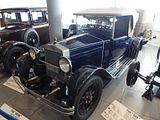
OM Superba 665 SSMM Castagna: The 665 Superba was introduced in 1923 and produced in several series and models until 1932. It was the best known and appreciated OM production model because of its racing wins, culminated in the first three positions at the first edition of the Mille Miglia in 1927. After the victory of the Alfa Romeo in the 1928 Mille Miglia, OM realised the importance of the supercharger and in 1929 introduced a new sports model with a Roots supercharger. From then on, OM models were available with or without supercharger, with over-head or side valves. The car on show in the museum is a 665 SSMM model; fitted with a Roots supercharger, is one of the cars the English OM importer modified, fitting cylinder heads with over-head instead of sides valves. The English heads were cast iron and the combustion side was “flat”. Domed pistons, because the low position of the sparkplugs did not leave room for trunk pistons. The cyclinder block was very special, made in cast iron with twelve 18mm sparkplugs, six on each side fixed in well-hidden holes. In the road version ignition was supplied with magneto, coil ignition and 6 cylinder spark coil. The racing models probably used two magnetos for double ignition. Thanks to the light and well shaped body built by Carrozzeria Castagna, the car could reach a speed of 150 kph.
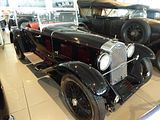
1927 Rolls Royce 20HP Hooper & Co: This is a beautiful and very rare 1927 Rolls Royce 20 HP. This marvellous vehicle made its debut in January 1927 when it was bought by Captain Thorpe for 1100 pounds! A real fortune in those days, especially since that was only for the chassis! The cars were, in fact, bought by the manufacturer as bare frames which were then “dressed” by the various bodyworkers according to their personal tastes. This 4-seater torpedo vehicle was fitted out by Hooper & Co Ltd, who, as the plates on the opened doors on each side show, were the official suppliers of His Majesty the King, the Queen and the Prince of Wales. The front seats are adjustable, the dashboard is made of mahogany. The glass fitted to protect the passengers in the two back seats was specifically requested by the owner as an optional for the modest sum of 10 pounds. At the time, the annual wage of an ordinary worker was only about 30 pounds. The two Rs of the brand are still red. In 1933 they will turn black: some say as a sign of mourning for Henry Royce, founder of the company (together with Charles Rolls), who died that same year; some other say it was because the color black could match body colours more easily.
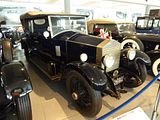
1908 SCAT “15/20 hp”, Munroe & Spons: SCAT (Società Cerano Automobili Torino) was established in 1906 by Giovanni Battista Ceirano, one of the brothers who were the pioneers of the Italian automobile industry and who also contributed to the founding of FIAT in 1899. Scat did not merely produce touring vehicles and did, in fact, take part in the 1911, 1912 and 1914 editions of the Targa Florio car race. This beautiful torpedo was found in Australia and, besides the original upholstery and paintwork having survived to present day in such a well-preserved state (note the green threading on the leaf springs and along the entire edge of the bodywork as well as on the wheel spokes), it was the first vehicle in the world to have a compressed air automatic start-up installed, the predecessor of electrical start-up used for the first time on the Cadillac in 1912. This absolute innovation at that time was a SCAT patent. The great Tazio Nuvolari, then SCAT’s exclusive representative in the Veneto region and the city of Mantua, was well aware that the SCAT car had remarkable quality. His representative offices were in Verona, as a signed letter on headed paper dated February 1st 1917 proves.
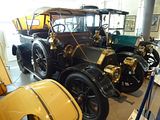
1921 Voisin C1: Gabriel Voisin, pioneer of French aviation, founded the “Société Anonyme des Aéroplanes G. Voisin“. Created to produce aircraft, at the end of the First World War the company was converted to car production using all the experience gained in the aircraft field. This led to the application of aeronautical studies, which had a large development during World War I, on car bodies: the wide use of aluminium, aerodynamics, functionality and originality. The badge of the firm shows a stylized dove whose shape recalls the Egyptian goddess Isis. In 1937, the economic crisis forced Gabriel Voisin to sell his shares; in 1940 the company was acquired by Gnome et Rhone and went back to aircraft production. We owe Gabriel Voisin several innovations such as the reverse light, Cotal electromagnetic gearbox use and large glass surfaces. The car displayed at the museum is fitted with a Knight type sleeve valve engine and the bodywork, created by Alfred Belvalette, has distinctive windows which could be folded and disappeared inside the door.
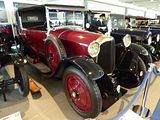
1912 Zedel “C.I. 12 HP”, Moniardet: The Zedel (or ZL acronym from the initials of the partners Zurcher and Luthi) automobile industry was active in Switzerland from the late 1800s till the 1920s. Initially producing motorcycle engines, in the early 1900s they started with the production of luxury cars. The car shown in the museum is a very rare 1912 C.I. 12 HP. Designed for the difficult Swiss mountain roads, the car shows some specifications such as the carburetor placed under the engine to allow a regular fuel flow even on highly gradient roads. This car still has original accessories and leather interior, and is fitted with carbide headlights with magnifying lens to allow a wider light beam expansion. Thanks to their cars quality, the Zedel had several sovereigns among their customers: it seems just this exact car was presented by the company to Queen Elena of Italy so that they could be titled “Suppliers of the Royal House”.
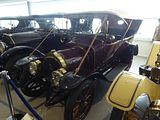
ENGINES
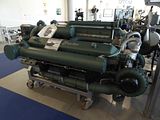
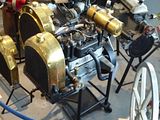

MOTOR BIKES
1956 Bianchi “Tonale 175cc” record: In 1956 the Tonale 175 won the Motogiro d’ Italia with Gino Franzosi and the Milano Taranto with Daminelli in the class “Stock derivatives“. At the end of 1956 Franzosi again in Castelfusano beat the mile record and missed the kilometer one by an inch. In 1957 the Tonale is wrapped with a special long fairing for the endurance records where Eng. Nardi, plane designer, worked on too. The frame was modified and the wheelbase is now longer. With this version on 19th November 1957 on Monza racetrack, the 1000km record was beaten with a time of 5h 23’ 9” averaging 185,664 km/h and the six hours one with 1114,428 km covered, averaging 185,721 km/h. This particular record version of the 175 Tonale is the one you can admire at Museo Nicolis with its sleek fairing, queen of the 1950s motorbike competitions.
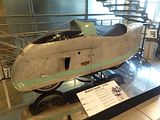
There are around 100 other motor bikes, ranging from machines which are around 100 years old to some much more modern ones.
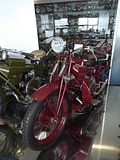
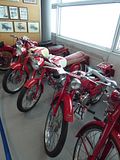
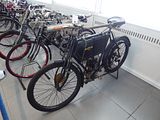

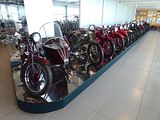
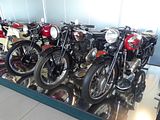
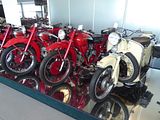

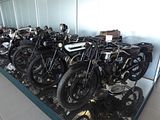
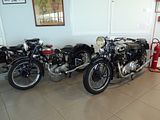
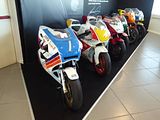
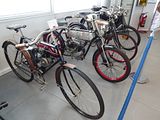
CYCLES
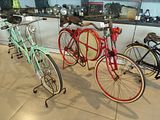
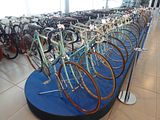
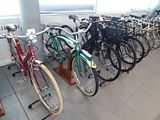
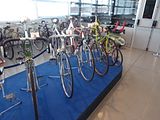
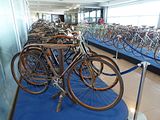
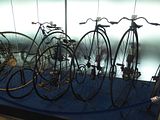
CAMERAS
There was a really collection of cameras here, around 500 in total, but most of them were in glass cases and the reflections completely precluded getting photos of them, so this is the only shot I managed.
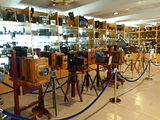
TYPEWRITERS
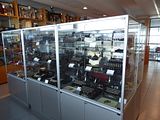
MUSICAL INSTRUMENTS


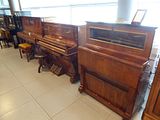
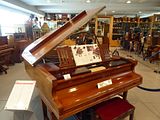
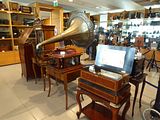
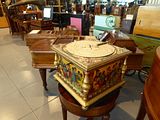
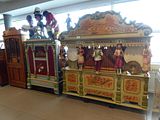
This is a fascinating place. It would be worth going just to see the cars, but the other displays over the upper floors are also really interesting, with all manner of items, some of which will be familiar but others will not be. More detail is available on the museum’s own website: https://www.museonicolis.com/en/

